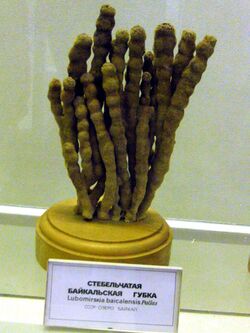Biology:Lubomirskiidae
From HandWiki
Short description: Family of sponges
| Lubomirskiidae | |
|---|---|

| |
| Museum specimen of Lubomirskia baicalensis (living are brighter green) | |
| Scientific classification | |
| Domain: | Eukaryota |
| Kingdom: | Animalia |
| Phylum: | Porifera |
| Class: | Demospongiae |
| Order: | Spongillida |
| Family: | Lubomirskiidae Rezvoi, 1936 |
Lubomirskiidae is a family of freshwater sponges from Lake Baikal in Russia.[1]
Lubomirskia baikalensis, Baikalospongia bacillifera and B. intermedia are unusually large for freshwater sponges and can reach 1 m (3.3 ft) or more.[2][3] These three are also the most common sponges in Lake Baikal.[2] Most sponges in the lake are typically green when alive because of symbiotic dinoflagellates (zoochlorella), but can also be brownish or yellowish.[4]
Genera and species
The family contains four genera and sixteen species:[5]
- Genus Baikalospongia Annandale, 1914
- Baikalospongia abyssalis Itskovich, Kaluzhnaya, Veynberg & Erpenbeck, 2017
- Baikalospongia bacillifera Dybowsky, 1880
- Baikalospongia dzhegatajensis Rezvoi, 1927
- Baikalospongia fungiformis Makushok, 1927
- Baikalospongia intermedia Dybowsky, 1880
- Baikalospongia martinsoni Efremova, 2004
- Baikalospongia recta Efremova, 2004
- Genus Lubomirskia Dybowsky, 1880
- Lubomirskia abietina Swartschewsky, 1901
- Lubomirskia baikalensis (Pallas, 1773)
- Lubomirskia fusifera Soukatschoff, 1895
- Lubomirskia incrustans Efremova, 2004
- Genus Rezinkovia Efremova, 2004
- Rezinkovia arbuscula Efremova, 2004
- Rezinkovia echinata Efremova, 2004
- Genus Swartschewskia Makuschok, 1927
- Swartschewskia irregularis Swartschewsky, 1902
- Swartschewskia khanaevi Bukshuk & Maikova, 2020
- Swartschewskia papyracea (Dybowsky, 1880)
References
- ↑ Paradina; Kulikova; Suturin; and Saibatalova (2003). The Distribution of Chemical Elements in Sponges of the Family Lubomirskiidae in Lake Baikal. International Symposium - Speciation in Ancient Lakes, SIAL III - Irkutsk 2002. Berliner Paläobiologische Abhandlungen 4: 151-157.
- ↑ 2.0 2.1 Kaluzhnaya; Belikov; Schröder; Rothenberger; Zapf; Kaandorp; Borejko; Müller; and Müller (2005). Dynamics of skeleton formation in the Lake Baikal sponge Lubomirskia baicalensis. Part I. Biological and biochemical studies. Naturwissenschaften 92: 128–133.
- ↑ Belikov; Kaluzhnaya; Schröder; Müller; and Müller (2007). Lake Baikal endemic sponge Lubomirskia baikalensis: structure and organization of the gene family of silicatein and its role in morphogenesis. Porifera Research: Biodiversity, Innovation and Sustainability, pp. 179-188.
- ↑ Müller; and Grachev, eds. (2009). Biosilica in Evolution, Morphogenesis, and Nanobiotechnology: Case Study Lake Baikal, pp. 81-110. Springer Publishing. ISBN:978-3-540-88551-1.
- ↑ de Voogd, N.J.; Alvarez, B.; Boury-Esnault, N.; Carballo, J.L.; Cárdenas, P.; Díaz, M.-C.; Dohrmann, M.; Downey, R.; Hajdu, E.; Hooper, J.N.A.; Kelly, M.; Klautau, M.; Manconi, R.; Morrow, C.C. Pisera, A.B.; Ríos, P.; Rützler, K.; Schönberg, C.; Vacelet, J.; van Soest, R.W.M. (2021). "Lubomirskiidae Weltner, 1895". WoRMS. World Register of Marine Species. http://www.marinespecies.org/aphia.php?p=taxdetails&id=167011.
Wikidata ☰ Q4117876 entry
 |

